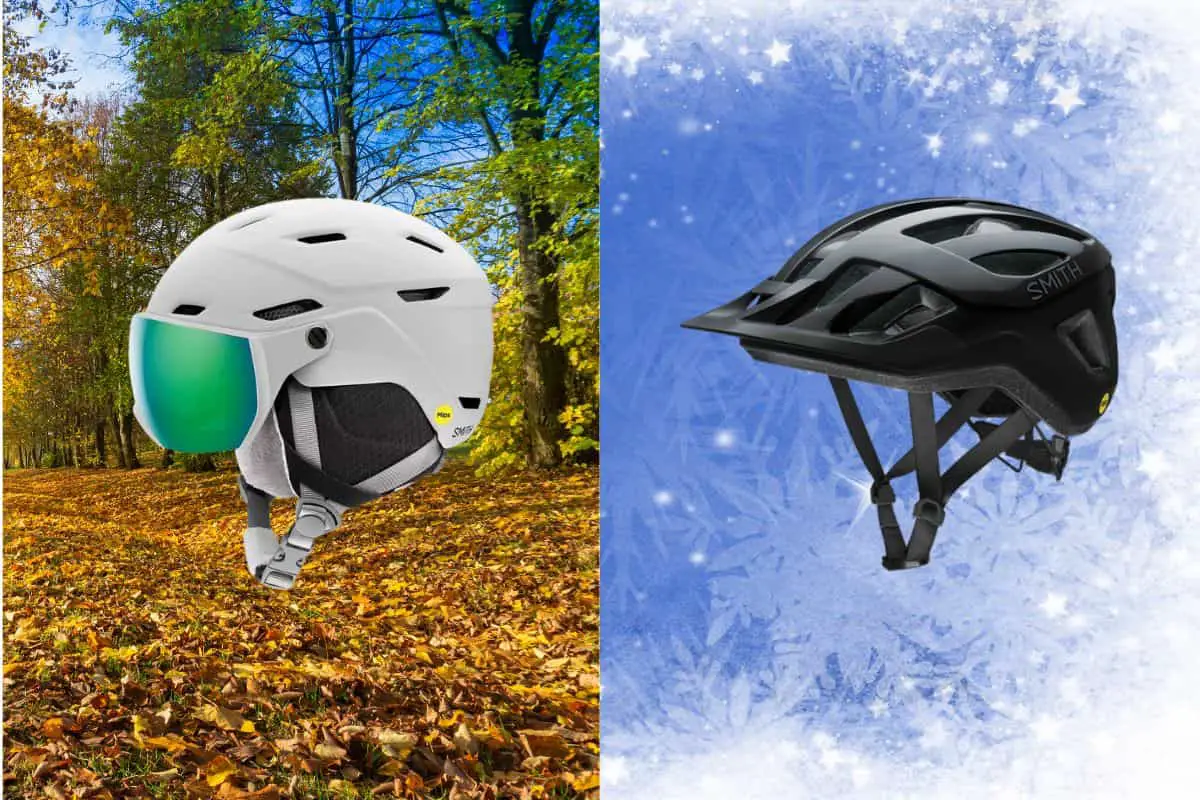Ski Helmet Vs Bike Helmet: Same or Different?
Helmet manufacturers recognize that different types of helmets will encounter different conditions. Thus, they design helmets for different types of falls on different types of surfaces. For example, falling on a road or gravel versus falling on ice or snow. The type of fall and the types of environmental conditions are not the same.
The main differences between ski helmets and bike helmets are in the design and functionality. Compare:
- ski helmets are round and smooth, while bike helmets are more aerodynamic in shape.
- ski helmets have all around coverage, whereas bike helmets focus on the top and back of the head.
- ski helmets have soft padding for warmth. Many bike helmets have sweat wicking, anti-microbial padding.
- ski helmets have small, adjustable air vents. Bike helmets have larger vents for cooling.
- ski helmets must follow safety standards ASTM F2040 or CE EN 1077. Bike helmets adhere to CPSC 1203 or CE EN 1078.
Page Content

Disclosure: As an Amazon Associate, we earn from qualifying purchases. Disclosure Statement.
Ski Helmet Vs Bike Helmet
Falling as a skier is not the same as falling off a bike. The angle of the fall is different. The ground surface is different. For these reasons, skiers and cyclists need different helmets with different protective coverage.
Skiing on icy slopes requires a helmet that can safeguard against tough impacts. Ski helmets have a round shape with a smoother surface. They provide extra coverage at the back and sides to protect against backward falls.
But, bike helmets concentrate on guarding against impacts to the upper head. They feature a more streamlined shape, prioritizing ventilation for comfort during high-speed cycling.
SUGGESTED: Ski & Snowboard Helmets For Big Heads
While ski and bike helmets share similarities, the differences are quite stark. For example, the helmet’s shape and ventilation caters to specific needs.
To ensure the right level of protection, you should always choose the right type of helmet. A snow helmet for skiing and snowboarding, a bike helmet for cycling.
Ski And Bike Helmets Key Features Comparison
| Feature | Ski Helmets | Bike Helmets |
|---|---|---|
| Impact Protection | Designed to protect against high-speed impacts and falls on hard snow or ice. Many ski helmets feature MIPS technology for added protection against rotational forces. | Designed to protect against impacts from falls or collisions on hard surfaces. Some bike helmets also feature MIPS technology for added protection against rotational forces. |
| Ventilation | Often feature adjustable ventilation systems to regulate temperature and prevent overheating. | Designed to provide airflow to keep the head cool during cycling. |
| Warmth | Built-in insulation to keep the head warm in cold weather conditions. | Designed to provide airflow and keep the head cool during cycling. |
| Goggle Compatibility | Designed for seamless integration with ski goggles. | Not designed for goggle compatibility. |
| Weight | Designed to be lightweight for comfort and performance. Not all brands. | Designed to be lightweight for comfort and performance during cycling. |

Ski & Bike Helmet Similarities
Ski and bike helmets share a common goal: to safeguard your head from impact during accidents. Also, the basic structure of ski helmets and bike helmets is similar.
Both helmets have a durable, lightweight outer shell made of polycarbonate or ABS. They also include an inner liner, molded from EPS or EPP foam, to absorb impact energy during a crash or fall. The chin strap on both helmets secures the helmet in place during such incidents.
Another way in which ski and bike helmets are similar is in their lifespan. No matter which helmet you wear, replacing it after 5 years is important if it is to protect your head.
Ski & Bike Helmet Differences
Shape: Ski helmets generally have a rounder shape, with a smooth surface. Much like a skate helmet. Bike helmets tend to be more aerodynamic promoting better airflow during high-speed rides.
RECOMMENDED: Ski & Snowboard Helmets With Visors
The round shape of a ski helmet allows the helmet to slide across the icy snow in case of a fall at speed. But, the vents or fins on a bike helmet could hook onto something, causing more injury to the skier.
Coverage: Bike helmets focus on protecting the upper and back of the head. In contrast, ski helmets provide coverage all around. The possibility of backward falls or collisions with obstacles like trees are common.
Ventilation: Both skiers and cyclists value helmet ventilation, but for different reasons. Bike helmets have larger vents for cooling airflow and preventing overheating.
Skiers also need ventilation for the same reasons as cyclists, but not all the time. For this reason, the vents on a ski helmet are often adjustable. The wearer can open or close the vents as dictated by the weather.
Ski helmet vents cannot be as large as on some bicycle helmets if they are to follow ASTM F2040 or CE EN 1077 standards. Both standards cause vents not to be large enough for a skier’s pole to enter the vent.
Ski helmet ventilation is also crucial for preventing goggle fogging. Small vents at the top of ski goggles release moist air via the helmet’s vents.

SUGGESTED: Ski & Snowboard Helmets With Bluetooth
This content was originally published on headsdontbounce.com. If it appears on another website, it is a violation of the copyright owned by headsdontbounce.com.
Dual Certified Helmets
Due to the demand for multi-use helmets, dual-certified bike/ski helmets hit the slopes. Now, individuals seeking a single helmet for both activities were finally catered for. These helmets meet the standards for both ski helmets and bike helmets.
Dual-certified ski/bike helmets often resemble skate helmets due to their versatile design. They provide more protection at the back than regular bike helmets. And have removeable ear-pads. A dual-certified helmet is for anyone seeking a helmet for both activities.
Comfort and Fit
When you’re skiing or biking, it is important that your helmet fits your head. Choosing a helmet that fits well will provide both comfort and protection.
RECOMMENDED: Ski & Ski Helmets with MIPS
At some ski resorts, there’s a rule that all skiers must wear certified safety gear with labels like ASTM/CE. These labels show that the helmet meets certain safety standards. So, if you’re planning to ski at your local resort, it might be a good idea to invest in a dual certified helmet.
Last Words
When you’re on a ski slope or bike trail, having the correct helmet is crucial. It’s all about safeguarding your head from injuries during the activity.
If you need a helmet that protects for both biking and skiing, a dual-certified helmet is a wise choice. These helmets have the same features as regular bike and ski helmets.
So, if you want one helmet to cover you for both skiing and cycling, then give some thought to a dual certified helmet. It’s a smart choice for enjoying more outdoor activities.
I hope we have covered the question of ‘ski helmet vs bike helmet’ to your satisfaction. If you enjoyed this article, take a look at the related reads below for some more interesting reads!
If you liked this post, why not share it with your friends.Related Reads:



